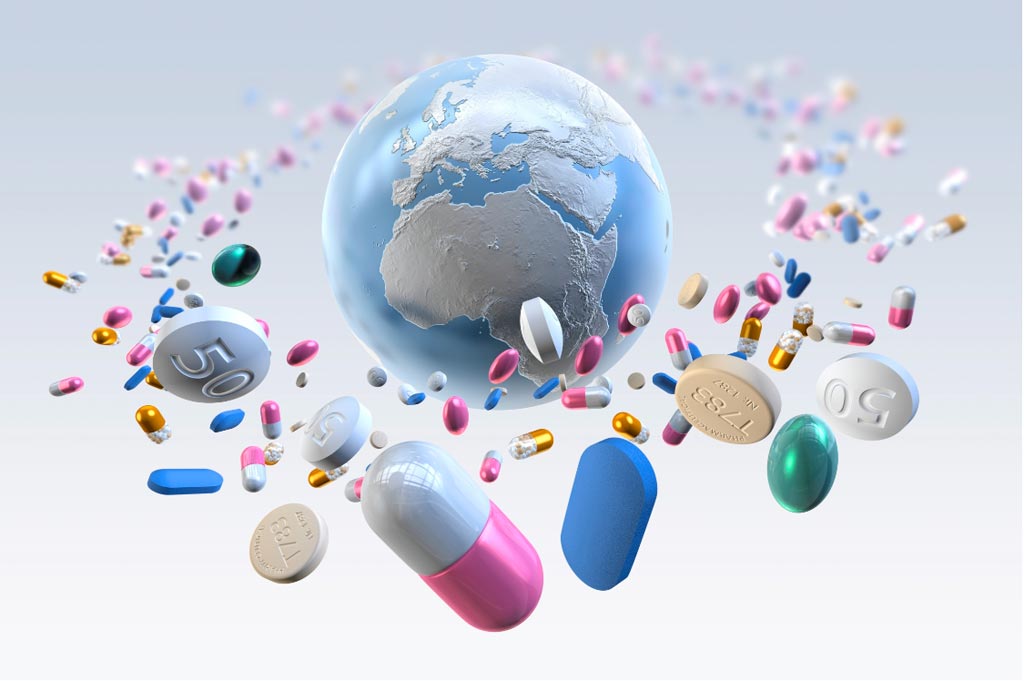WHO Revises and Updates Essential Medicines List
|
By HospiMedica International staff writers Posted on 06 Jul 2017 |

Image: The World Health Organization has updated the essential medicines list (Photo courtesy of Fotosearch).
The World Health Organization (WHO, Geneva, Switzerland) Essential Medicines List (EML) for 2017 includes the biggest revision of the antibiotics section ever seen and new additions for hepatitis C virus (HCV), HIV, tuberculosis, and leukemia.
The updated EML adds 30 medicines for adults and 25 for children, and specifies new uses for nine already-listed products, bringing the total to 433 drugs deemed essential for addressing the most important public health needs. The revised antibiotics section now groups antibiotics into three categories:
ACCESS – antibiotics that should be available at all times as treatments for a wide range of common infections. For example, it includes amoxicillin, a widely used antibiotic to treat infections such as pneumonia.
WATCH - antibiotics that are recommended as first- or second-choice treatments for a small number of infections. For example, use of ciprofloxacin, used to treat cystitis (a urinary tract infection) and upper respiratory tract infections (such as bacterial sinusitis and bacterial bronchitis), should be dramatically reduced to avoid further development of resistance.
RESERVE - antibiotics such as colistin and some cephalosporins that should be considered last-resort options, and used only in the most severe circumstances when all other alternatives have failed, such as life-threatening infections due to multidrug-resistant bacteria.
The new categories are intended to ensure antibiotics are available when needed, and that the right antibiotics are prescribed for the right infections, so that they enhance treatment outcomes, reduce the development of drug-resistant bacteria, and preserve the effectiveness of "last resort" antibiotics that are needed when all others fail. The changes support the WHO Global action plan against antimicrobial resistance development in 21 of the most common general infections. If shown to be useful, the list could be broadened in future versions of the EML.
“The rise in antibiotic resistance stems from how we are using – and misusing – these medicines,” said Suzanne Hill, MD, director of essential medicines and health products at the WHO. “The new WHO list should help health system planners and prescribers ensure people who need antibiotics have access to them, and ensure they get the right one, so that the problem of resistance doesn’t get worse.”
The updated EML also includes several new drugs, such as two oral cancer medicines (dasatinib and nilotinib); sofosbuvir + velpatasvir, the first combination therapy that treats all six types of HCV; dolutegravir, a more effective treatment for HIV, as well as an older drug that can be taken to prevent HIV infection in people at high risk; delamanid, a new pediatric formulations for the treatment of children and adolescents with multidrug-resistant tuberculosis (MDR-TB); and several other drugs.
Related Links:
World Health Organization
The updated EML adds 30 medicines for adults and 25 for children, and specifies new uses for nine already-listed products, bringing the total to 433 drugs deemed essential for addressing the most important public health needs. The revised antibiotics section now groups antibiotics into three categories:
ACCESS – antibiotics that should be available at all times as treatments for a wide range of common infections. For example, it includes amoxicillin, a widely used antibiotic to treat infections such as pneumonia.
WATCH - antibiotics that are recommended as first- or second-choice treatments for a small number of infections. For example, use of ciprofloxacin, used to treat cystitis (a urinary tract infection) and upper respiratory tract infections (such as bacterial sinusitis and bacterial bronchitis), should be dramatically reduced to avoid further development of resistance.
RESERVE - antibiotics such as colistin and some cephalosporins that should be considered last-resort options, and used only in the most severe circumstances when all other alternatives have failed, such as life-threatening infections due to multidrug-resistant bacteria.
The new categories are intended to ensure antibiotics are available when needed, and that the right antibiotics are prescribed for the right infections, so that they enhance treatment outcomes, reduce the development of drug-resistant bacteria, and preserve the effectiveness of "last resort" antibiotics that are needed when all others fail. The changes support the WHO Global action plan against antimicrobial resistance development in 21 of the most common general infections. If shown to be useful, the list could be broadened in future versions of the EML.
“The rise in antibiotic resistance stems from how we are using – and misusing – these medicines,” said Suzanne Hill, MD, director of essential medicines and health products at the WHO. “The new WHO list should help health system planners and prescribers ensure people who need antibiotics have access to them, and ensure they get the right one, so that the problem of resistance doesn’t get worse.”
The updated EML also includes several new drugs, such as two oral cancer medicines (dasatinib and nilotinib); sofosbuvir + velpatasvir, the first combination therapy that treats all six types of HCV; dolutegravir, a more effective treatment for HIV, as well as an older drug that can be taken to prevent HIV infection in people at high risk; delamanid, a new pediatric formulations for the treatment of children and adolescents with multidrug-resistant tuberculosis (MDR-TB); and several other drugs.
Related Links:
World Health Organization
Latest Critical Care News
- 'Universal' Kidney to Match Any Blood Type
- Light-Based Technology to Measure Brain Blood Flow Could Diagnose Stroke and TBI
- AI Heart Attack Risk Assessment Tool Outperforms Existing Methods
- Smartphone Imaging System Enables Early Oral Cancer Detection
- Swallowable Pill-Sized Bioprinter Treats GI Tract Injuries

- Personalized Brain “Pacemakers” Could Help Patients with Hard-To-Treat Epilepsy
- Microscopic DNA Flower Robots to Enable Precision Medicine Delivery
- Origami Robots to Deliver Medicine Less Invasively and More Effectively
- Improved Cough-Detection Technology Aids Health Monitoring
- AI Identifies Children in ER Likely to Develop Sepsis Within 48 Hours
- New Radiofrequency Therapy Slows Glioblastoma Growth
- Battery-Free Wireless Multi-Sensing Platform Revolutionizes Pressure Injury Detection
- Multimodal AI to Revolutionize Cardiovascular Disease Diagnosis and Treatment
- AI System Reveals Hidden Diagnostic Patterns in Electronic Health Records
- Highly Sensitive On-Skin Sensing Monitor Detects Vitamin B6 and Glucose in Sweat
- Artificial Intelligence Revolutionizing Pediatric Anesthesia Management
Channels
Surgical Techniques
view channel
Minimally Invasive Endoscopic Surgery Improves Severe Stroke Outcomes
Intracerebral hemorrhage, a type of stroke caused by bleeding deep within the brain, remains one of the most challenging neurological emergencies to treat. Accounting for about 15% of all strokes, it carries... Read more
Novel Glue Prevents Complications After Breast Cancer Surgery
Seroma and prolonged lymphorrhea are among the most common complications following axillary lymphadenectomy in breast cancer patients. These postoperative issues can delay recovery and postpone the start... Read morePatient Care
view channel
Revolutionary Automatic IV-Line Flushing Device to Enhance Infusion Care
More than 80% of in-hospital patients receive intravenous (IV) therapy. Every dose of IV medicine delivered in a small volume (<250 mL) infusion bag should be followed by subsequent flushing to ensure... Read more
VR Training Tool Combats Contamination of Portable Medical Equipment
Healthcare-associated infections (HAIs) impact one in every 31 patients, cause nearly 100,000 deaths each year, and cost USD 28.4 billion in direct medical expenses. Notably, up to 75% of these infections... Read more
Portable Biosensor Platform to Reduce Hospital-Acquired Infections
Approximately 4 million patients in the European Union acquire healthcare-associated infections (HAIs) or nosocomial infections each year, with around 37,000 deaths directly resulting from these infections,... Read moreFirst-Of-Its-Kind Portable Germicidal Light Technology Disinfects High-Touch Clinical Surfaces in Seconds
Reducing healthcare-acquired infections (HAIs) remains a pressing issue within global healthcare systems. In the United States alone, 1.7 million patients contract HAIs annually, leading to approximately... Read moreHealth IT
view channel
Printable Molecule-Selective Nanoparticles Enable Mass Production of Wearable Biosensors
The future of medicine is likely to focus on the personalization of healthcare—understanding exactly what an individual requires and delivering the appropriate combination of nutrients, metabolites, and... Read moreBusiness
view channel
Philips and Masimo Partner to Advance Patient Monitoring Measurement Technologies
Royal Philips (Amsterdam, Netherlands) and Masimo (Irvine, California, USA) have renewed their multi-year strategic collaboration, combining Philips’ expertise in patient monitoring with Masimo’s noninvasive... Read more
B. Braun Acquires Digital Microsurgery Company True Digital Surgery
The high-end microsurgery market in neurosurgery, spine, and ENT is undergoing a significant transformation. Traditional analog microscopes are giving way to digital exoscopes, which provide improved visualization,... Read more
CMEF 2025 to Promote Holistic and High-Quality Development of Medical and Health Industry
The 92nd China International Medical Equipment Fair (CMEF 2025) Autumn Exhibition is scheduled to be held from September 26 to 29 at the China Import and Export Fair Complex (Canton Fair Complex) in Guangzhou.... Read more














